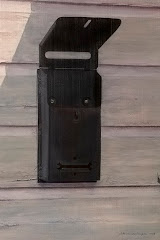
Just a Hint of French
We spent the Christmas holiday on Cedar Key, where homes are built on the second floor. The first floor is left empty to minimize damage if and when tides come rushing in at the front of a hurricane.
There was no storm during our stay. Just a few days of blessed peace and quiet, and some retired snowbirds taking their winter residence far from Ontario, Quebec and other cold, dark places.
Speaking to such neighbors put me in a Frenchie sort of mood when I saw the woman above from "our" second-story porch. "Madame et la Petite" (A Ladie and the Little One).
All that was missing was the panier, the bread basket, on her bike. That would set the stage for a trip to town and the purchase of groceries for the evening meal. Something flavorful.
The dog would poke along, sniffing at all the usual spots and marking as many as time and fluid would allow, then run to catch up with Madame.
In town, Madame would select some choice cuts of meat and eye the butcher's thumb as he weighed them. That bagette, a bottle of wine and some fresh-cut flowers would round out the purchase.
The trip home would involve the usual sharp calls to the dog, who would chase the same cat, bark back at that same big spotted hound, and wander down the same trail she always does.
Madame might even use some of those rougher French phrases that slip out when la petite isn't as charming as she is at home.
Back at home, the evening meal would be prepared. The small house would fill with the aroma of things to come. The dog would curl up in the pool of fading sunlight at the base of the storm door. The wine would be airing out on the table by the new flowers in the vase.
The winter sun would set beyond the bayou across the street.
But, of course, that didn't happen. It was just a neighbor taking an afternoon ride.
Art is the spice that adds flavor to an ordinary meal.




















